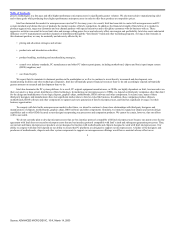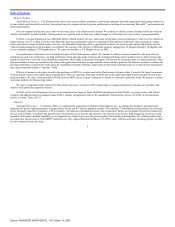AMD 2002 Annual Report Download - page 20
Download and view the complete annual report
Please find page 20 of the 2002 AMD annual report below. You can navigate through the pages in the report by either clicking on the pages listed below, or by using the keyword search tool below to find specific information within the annual report.
Table of Contents
ITEM 7. MANAGEMENT’S DISCUSSION AND ANALYSIS OF FINANCIAL CONDITION AND RESULTS OF OPERATIONS
The following discussion should be read in conjunction with the consolidated financial statements and related notes as of December 29, 2002 and
December 30, 2001 and for each of the three years in the period ended December 29, 2002, which are included in this annual report.
Critical Accounting Policies
Our discussion and analysis of our financial condition and results of operations are based upon our consolidated financial statements, which have been
prepared in accordance with accounting principles generally accepted in the United States. The preparation of these financial statements requires us to make
estimates and judgments that affect the reported amounts in our consolidated financial statements. On an on-going basis, we evaluate our estimates, including
those related to our investments, allowance for doubtful accounts, revenues, inventories, asset impairments, restructuring charges, income taxes, commitments
and contingencies. We base our estimates on historical experience and on various other assumptions that we believe to be reasonable under the circumstances, the
results of which form the basis for making judgments about the carrying values of assets and liabilities. Actual results may differ from these estimates or the
results of our estimates may be affected by different assumptions or conditions.
We believe the following critical accounting policies relate to those policies that are most important to the presentation of our financial statements and
require the most difficult, subjective and complex judgments.
Investments in Debt and Equity Securities. We hold minority interests in companies having operations or possessing technology primarily in areas within
our strategic focus, some of which are publicly traded and have highly volatile stock prices. We also make investments in marketable equity and debt securities.
We record an investment impairment charge when we believe an investment has experienced a decline in value that is other-than-temporary. In determining if a
decline in market value below cost for a publicly traded security or debt instrument is other-than-temporary, we evaluate the relevant market conditions, offering
prices, trends of earnings, price multiples and other key measures providing an indication of the instrument’s fair value. For private equity investments, we
evaluate the financial condition of the investee, market conditions, trends of earnings and other key factors that provide indicators of the fair value of the
investment. When a decline in value is deemed to be other-than-temporary, we recognize an impairment loss through a charge to interest income and other, net in
the current period to the extent of the decline below the carrying value of the investment. Adverse changes in market conditions or poor operating results of
underlying investments could result in additional other-than-temporary losses in future periods.
Allowance for Doubtful Accounts. We evaluate the collectibility of our accounts receivable based on a combination of factors. In circumstances where
we are aware of a specific customer’s inability to meet its financial obligations to us, we record a specific allowance against amounts due to reduce the net
recognized receivable to the amount we reasonably believe will be collected. For all other accounts receivable due from customers, we recognize allowances for
doubtful accounts based on the current business environment and our historical collection and write-off experience. If the financial condition of our customers
were to deteriorate or if economic conditions worsened, additional allowances may be required in the future, resulting in additional charges to our operating
results.
Revenue Reserves. We record a provision for estimated sales returns and allowances on product sales in the same period as the related revenues are
recorded. We base these estimates on actual historical sales returns, allowances and other known factors. Actual returns and allowances could be different from
our estimates and current provisions, resulting in future adjustments to our operating results.
Inventory Valuation. At each balance sheet date, we evaluate our ending inventories for excess quantities and obsolescence. This evaluation includes
analyses of sales levels by product and projections of future demand.
15
Source: ADVANCED MICRO DEVIC, 10-K, March 14, 2003
























